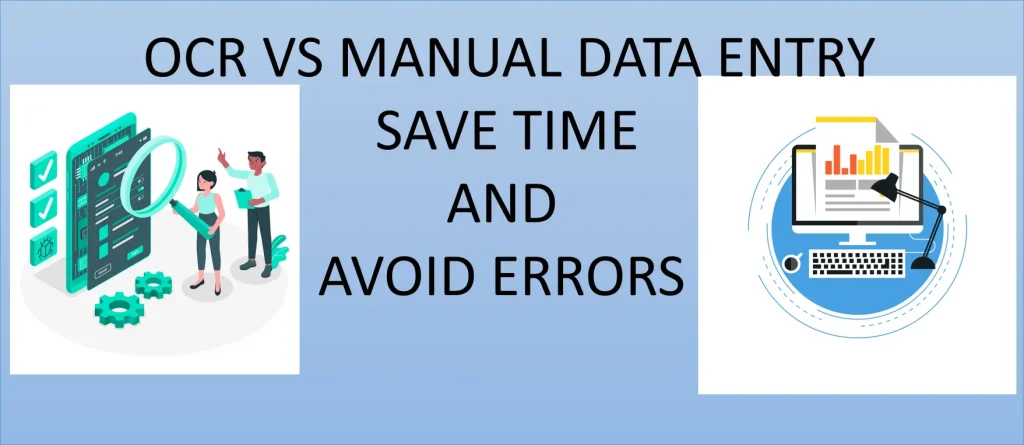OCR vs Manual Data Entry: Save Time and Avoid Errors
In today’s fast-paced digital environment, businesses must process large volumes of data efficiently and accurately. The choice between manual data entry and OCR (Optical Character Recognition) can significantly impact productivity, cost, and error rates. While manual data entry has its merits, automated workflows powered by OCR are increasingly becoming the go-to solution for organizations looking to streamline operations.
In this article, we aim to bring about a comparison of manual vs automated workflows, highlight the data entry challenges, and showcase the OCR benefits for accuracy and efficiency.

Key Differences Between OCR and Manual Data Entry
1. Speed
- Manual Data Entry: Human operators take time to read, interpret, and input data. Processing large datasets can take hours or even days.
- OCR: Automates the extraction of text from scanned documents and images, completing tasks in seconds or minutes.
Illustration: A single employee manually processing 1,000 invoices may require 40 hours, whereas OCR can handle the same workload in under an hour.
2. Accuracy
- Manual Data Entry: Prone to human errors, including typos, misinterpretations, and omissions. Error rates increase with fatigue and repetitive tasks.
- OCR: AI-powered OCR tools achieve high accuracy, especially when supported by image preprocessing and contextual analysis.
Example: OCR systems can accurately extract complex numeric data from financial documents, reducing the risk of costly mistakes.
3. Cost Efficiency
- Manual Data Entry: Requires dedicated personnel, leading to higher long-term labor costs. Additional expenses include training and supervision.
- OCR: One-time setup costs and minimal ongoing expenses make it a more cost-effective solution, especially for repetitive tasks.
Comparison Table:
| Metric | Manual Data Entry | OCR |
|---|---|---|
| Speed | Slow | Fast |
| Accuracy | Moderate | High |
| Cost per 1,000 Docs | $300+ | $50-$100 |
| Scalability | Limited by workforce | Easily scalable |
4. Scalability
- Manual Data Entry: Adding more data requires hiring additional staff, which can delay scaling and inflate costs.
- OCR: Easily handles increasing volumes without the need for extra resources. Advanced tools like Picture2Txt.com adapt to large-scale projects effortlessly.
Scenario: A logistics company uses OCR to process shipping labels for thousands of packages daily. Scaling this with manual entry would require a large team and extended processing times.
When Manual Data Entry Is Still Relevant
Despite OCR’s advantages, there are situations where manual entry remains necessary:
- Creative Interpretation: For documents requiring subjective judgment or creative input, such as analyzing handwritten letters with personal flair.
- Exception Handling: Complex cases with inconsistent formats or poor-quality scans may need human review.
- One-Time Projects: Small-scale tasks that don’t justify the investment in OCR software may be handled manually.
Best Approach: Combine OCR with manual data entry for tasks requiring validation or creative insights. For example, OCR can handle 95% of the workload, while humans focus on anomalies or special cases.
Benefits of OCR Adoption
1. Time Savings
OCR accelerates data processing, freeing up valuable time for employees to focus on strategic activities rather than repetitive tasks.
2. Error Reduction
By automating text recognition, OCR minimizes typos, omissions, and formatting errors, improving data quality and compliance.
3. Enhanced Productivity
OCR eliminates bottlenecks in workflows, enabling faster decision-making and better resource allocation which eventually boosts productivity.
4. Cost Reduction
With lower operational costs, OCR delivers significant ROI, especially for businesses handling high volumes of documents.
Case Study: A healthcare provider used OCR to digitize patient records, reducing processing time by 80% and saving $50,000 annually in labor costs.
Embrace the Future with OCR
The debate between manual vs automated workflows is clear—OCR offers unmatched advantages in terms of speed, accuracy, and cost-effectiveness.
If your business is ready to reduce errors, save time, and improve efficiency, explore cutting-edge OCR solutions like Picture2Txt.com. Start automating your workflows today and experience the transformative power of OCR technology!
